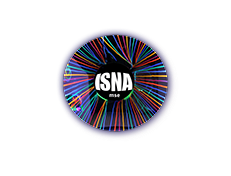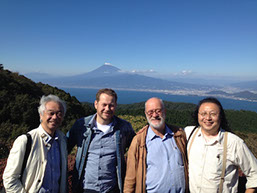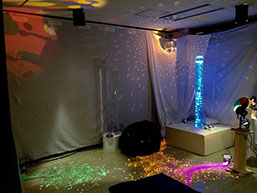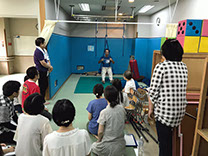Japan

Last year Ad Verheul and his co worker Gert ten Hoven ( care manager at the Centre De Hartenberg) visited the Art Centre Iruka in Osaka , Japan. The main purpose was an art exhibition of art works of the inhabitants of centre De Hartenberg and Art Centre Iruka. Also some presentations about Snoezelen were in the program. The director of the Art Centre Iruka, Mr. Seichi Ihara is also very active to stimulate the concept of Snoezelen. He organized a temporally Snoezelen room in cooperation with the Suminoe Ward Director Mr. Takahashi and Mr. Dick Kosuga. It was a wonderful experience
Read more, click on the picture.
a temperary Snoezelen room in a townhal in a part of Osaka, Japan.
the purpuse of this room is to tell people about people with limitations, and the what we can offer them.
See what Mr. Seichi tells about this, and also some more pictures.
Snoezelen in Japan
The start and history of the Japanese Snoezelen Association JSA
Written by Yuko Yamaka (former vice representative of the Japan Snoezelen Association)
I would like to introduce our association and report the situation of Snoezelen in Japan in my paper. Our association was founded in 1998. The purpose of our association is to inform people about what Snoezelen is and that the most important thing about Snoezelen is the philosophical aspect. Before I write these things, I would like to tell you how we encountered Snoezelen and why we decided to found our association.
In the end of the 80s I was working as a clinical psychologist in an institution for people with profound multiple learning difficulties. I was interested in how to raise the QOL (quality of life) of those people. I built up a relaxing room with my colleagues. That was a very simple room with soft light, air cushions and soft music. We just wanted to offer people with profound handicaps a safe, comfortable time and space. Many people came and enjoyed this small space very much. In 1991 I attended a certain overseas study program and took lectures in Germany. I met a gentleman who was a representative of a parents association. His name is Mr. Mutter. I asked him to recommend me the best institution in Europe from parents point of view. He thought for a second and gave me a small paper on which the name Center De Hartenberg, Mr. Verheul, and a telephone number was written. I called Mr. Verheul and told him that I wanted to visit his Center. Mr. Verheul was very friendly and warm and replied that he would welcome me.
Then I visited the Center De Hartenberg and met Mr. Verheul. He brought me together with some students from Germany to a Snoezelen room. I was astonished at the space and the equipment. My instinct said to me "that is it!" It seemed this was exactly what we had searched for to offer better service to our people. After looking at the Snoezelen area, I had some time to hear about the philosophical aspects of Snoezelen from Mr. Verheul. His explanations sounded very understandable to me and I was full of real hope. He told me that he and his colleagues always thought whether they offered the service to people with very profound handicaps or to people who could satisfy themselves. Also that they studied about people with severe handicap and realized, those people need environment with suitable stimulus, and people with profound handicap feel the outside world directly through their senses.
Mr. Verheul and his colleagues started with trial and error to make such an environment. As a result, people who have very profound handicaps feel as comfortable with the space and equipment they made as people without handicaps. He said that by repeating to have experiences together in this environment, he and the other staff discovered many things and felt that the way to see the handicapped has changed step by step. People with and without handicap can have the same meaningful time together and realize we have the same important life and our own characters. He also said to me that such a change of idea for people with profound handicap might be able to change the sense of value for lives of all people. That was a quite new and fresh idea for me. I was very impressed and encouraged by his thought. I think this is the most important core of the philosophical aspect of Snoezelen.
As soon as I returned to my country, I told my boss and colleagues about Snoezelen. Few of them showed interest in my reports. It was because most people were enthusiastic to rehabilitation. Few people considered QOL of those people seriously. Some of my colleagues recognized the principles of Snoezelen and we developed our relaxing area with combinations of cheap materials and started to call this space 'Snoezelen corner'. Many more people got to visit this space from their ward. Many care staff said it would be necessary to build up a permanent Snoezelen Room. That was the reaction to our area.
In 1993 another colleague attended an overseas study program and spent 6 weeks in the Center De Hartenberg . She studied about Snoezelen in more detail. Thanks to her, our understanding of Snoezelen is deepened. We became able to talk about Snoezelen with more confidence.
The practice of Snoezelen spread from ward to ward. Also we got several opportunities to write about Snoezelen in journals. We also did several researches to show what happens with people with profound handicaps and carestaff through Snoezelen practice and reported them at the academic meetings. Soon after, many people visited our institution to see the Snoezelen area and our practice work. We worked very hard to introduce Snoezelen into our institution in Japan.
By such a way the word "Snoezelen" spread especially into the care-giving field for people with profound multiple learning difficulties in our country. In 1995 we got a big donation from the charity organization and built the white room in my institution. This was the first white room in Japan. This organization also gave money to every ward in our institution. Surprisingly, 5 of 6 wards bought Snoezelen equipment.
Why we founded Japan Snoezelen Association
As Snoezelen has spread wider, lots of misunderstandings happened. Many people thought Snoezelen as a new sensory therapy and looked for effects for behavior problems. Some people said Snoezelen would make the staff lazy, because they lie comfortably on a soft mat with people with handicaps. Teachers said Snoezelen was not suitable for the education which they thought should be the one to promote development of children. We thought these things happened because people did not know what the most important thing about Snoezelen is. We thought people should understand that Snoezelen is a deep philosophy. Through the practice of Snoezelen we can get lots of enlightenment and have deep insight about the presence and the interaction of human beings. By this recognition the way to see people with handicap will change and the barrier between us will vanish. Also Snoezelen will distribute to better QOL of these people.
At the same time our institution had received lots of inquiries about the concept, the space, the equipment and the practice of Snoezelen, and so on. We felt the necessity of a system where we can inform people about Snoezelen properly and exchange mutual experiences. So we founded Japan Snoezelen association and started our activities 1998.
Organization
Our association consists of several administrative staff members and general members. The administrative staff consists of a representative, two vice representatives, four directors and two audits. All administrative staff members have their own professions. For example our representative, Mr. Ayuha, runs a big social welfare organization and many institutions under it.
I myself have been working with people with profound handicaps as a psychologist for 20 years. So we work for the association almost as volunteers. General members pay annual fee and get newsletters from the association several times a year from which they can learn about new results, new equipment and the practice of other institutions and so on. General members can also get a discount of attendance fee of workshops and seminars held by our association.
The purpose
We have three main purposes. They are education, information and networking. We are especially careful to inform people about the philosophy and practice of Snoezelen properly. As I wrote before, we were very impressed with the lecture of Mr. Verheul and his compassion. We want everybody to know Mr. Verheul's original philosophy. We try to develop our activities and make Snoezelen understood by many people. We hope, through experiences of Snoezelen people discover and realize many things about life, interaction between people and the status of people with handicaps and our mind may change. We have the same important life, our own character, the right to live lifes of ourselves.
Activities
1. Seminar
We hold seminars twice a year. Every time 200 or 300 people come from all over Japan. The seminar is a combination of a main lecture and reports about practice of Snoezelen from several institutions. In the main lecture, we repeat what Snoezelen is and show the importance of its philosophy. We invite sometimes a lecturer
from European countries and sometimes we give lectures ourselves. The summer of 2004 was special, because Mr. Verheul came far away from the Netherlands to our country as a main lecturer.
After the main lecture several institutions report about their practice of Snoezelen. Audience and advisers ask questions or give suggestions or advice. We can recognize whether people understand the philosophy properly. The quality of the reports is rising, especially for these few years.
2. Workshop
We also hold a workshop twice a year. This is a combination of a main lecture and the practice. Audience watches the practice demonstration by video in the hall. We give explanations and comments about reactions of people, how the staff should behave and discuss the session in the audience.
It is very difficult to explain how we should help or behave with people in Snoezelen because every person is different from each other, and even the same person may show different reactions through repetition of Snoezelen activities. By having the para-experience together, we can share understandings and ideas.
3. Lecture
We are often invited to institutions to give a lecture. Each institution has its own problems. Some institutions already prepare the Snoezelen room, but they do not know how to inform other staff what Snoezelen is and how to use the room. In some institutions all the staff is keen on introducing Snoezelen, but they don't have enough budget. We tell them about our experiences or suggest contacts with the charity organization. This private lecture can answer each institution's own problems.
4. Newsletters
We publish newsletters 5-6 times a year. In those letters we repeat what Snoezelen is. I think many readers may memorize these sentences. There are scripts about books, references, new equipment, practice of other institutions and the report of the seminar or workshop. Readers can get new information and exchange mutual practice.
5. Collecting reference and books
It is very difficult for us Japanese to collect references of Snoezelen. Most of them are written in European languages. We try to collect references, books and videos in English. But most Japanese feel difficulties in reading and listening to English. It will become an important task for the staff of our association to translate them into Japanese.
6. Home Page
We made a home page of our association. Through this home page we introduce our association and Snoezelen. We also inform about the schedule of seminars and workshops. We made a Q and A corner and try to answer questions from many people. Our home page is in Japanese. We like to make an English version and link it to other home pages worldwide.
7. Publishing, Video, CD-ROM
We prepare our original materials with which people can learn about Snoezelen.
a) A book: "Snoezelen - activities for people with profound handicaps". This is the first book about Snoezelen written in Japanese. The author is Ms. Kiyoko Suzuki who is the president of our association. In this book the philosophy of Snoezelen is introduced in an understandable and gentle way. Also Snoezelen in European countries is introduced. This book is a little leaflet, but full of information and very helpful.
b) CD-ROM: This is the lecture by Mr. Bert Van der Stappen and Ms. Maria Van Oekelen who run a family support center "Het Balanske" in Belgium. We have invited them twice as lecturers. Their lecture was very logical and they are influenced by the philosophy of Mr. Verheul.
c) Video: We gathered some images of several Snoezelen rooms and made tapes. People can imagine the atmosphere of a Snoezelen space and get some ideas to build up their own room.
We now plan to publish a second book. In this book we would like to write about the philosophy of Snoezelen and its historical meaning in the field of social welfare. We also would like to write about the knowledge which is necessary for the practice of Snoezelen like physiology of sense, developmental psychology, the way of observation, the right attitude, or communication techniques.
Snoezelen in Japan
Next I would like to introduce the situation of Snoezelen in Japan. As I have told at the beginning of my paper, Snoezelen has got to be well known in the field of care-giving for people with an intellectual handicap, especially among the institutions for people with profound multiple learning difficulties in my country. Most institutions of this type are under control of the medical law and the social welfare law. So you may imagine inhabitants are almost bedridden and need constant medical care. It was very difficult to offer meaningful time to these people. Snoezelen was the big glad tiding. Some institutions introduce Snoezelen even into the intensive care unit.
Many people live there with very high risk. But they also have the right to enjoy and to live their own life. People who are living with the help of a medical machine can be released from the burden of pain by living in the atmosphere of Snoezelen, even if it is temporally. We can see a shine in their eyes and a gentle smile in their faces. Of course we must make a rigid teamwork among doctors, other medical staff and care staff to realize a safe Snoezelen activity in such a serious circumstance.
Most of these kinds of institutions have their own Snoezelen room or some Snoezelen equipment and have started to work in practice. The white room is very popular in this field. Every time at the seminar several institutions report their practice and we can see how much Snoezelen distributes to QOL of people with profound handicaps and how much care-staff learn about humanity, handicaps, interaction between people and life. Snoezelen has been expanding very rapidly into other types of institutions and service systems.
a) Day center for children with handicaps
Children show different reactions from adults to the Snoezelen practice, no matter how heavy their handicaps are. They seem to be excited to enjoy Snoezelen as if they would stay in Disney Land. We, the care-staff, can see that children are children. They are interested in everything around them and try to have fun. In Snoezelen practice we can offer children with handicaps many fantasies in a safe and understandable way.
Children learn to enjoy themselves and care-staff and parents can learn what is necessary for the childhood. It also makes parents happy to see the big smile of their own child.
It seems to be the tendency that younger parents easily accept the activities like Snoezelen, but parents in an older generation do not. They want to see their children to attend more structured activities or keep rehabilitation training. Such a phenomenon happens because to the difference of the sense of value for the human lives. We see the historical stream of social welfare by this thinking.
b) Sheltered Workshop
Many sheltered workshops now tried to introduce Snoezelen into their concept. In Japan people with a light intellectual handicap are working in this type of place. Most of them can speak freely. It seems easy to communicate by language. But we must know how difficult it is to talk about our own mind instead strictly with words. Many of the people with a certain intellectual handicap have an emotional unbalance. Some get easily excited or aggressive, some easily give up. By offering the quiet circumstance like a white room, they settle down again. And they can come back to their job place again. At first the staff should observe people and recommendthem to take a rest in a Snoezelen room. In many cases by repeating these experiences people get to know how to make use of a Snoezelen room. When people feel somewhat uneasy, they go to a Snoezelen room and settle down themselves. Some can keep stable just reminding them, that there is a Snoezelen room and that they can go there any time they want.
For people with mental health problems
We have several case reports about Snoezelen for people with mental health problems. In the sheltered workshop or the day center for people with intellectual handicaps, there are some people with mental health problems. This is partly because there are not enough support systems for these people. Medical care for those people is mainly the medication. I must admit the psychiatric field in Japan is still not interested in making an environment of relaxation and healing. Our association has now three case reports about people with schizophrenia. They are all in the progressed level. Some live in their home, taking constant medication from the hospital. They often show panic behaviors. We recommended them to take a rest in a white room. At the beginning, they needed long time to settle down. But by making use of a Snoezelen room repeatedly, they have learned to use the room for a better feeling and to settle down. One gentleman has begun to speak about the pain of his heart and his dreams after some sessions of mental relaxation. Normally he never spoke about himself.
Another example is a lady who lived more than 10 years in a psychiatric hospital. At the first day in the day center, she found herself in the white room. She seemed to decide this was her place. Since this day, every time she visited the day center she went directly to the white room. She laughed and talked about many things and was happy. Her doctor said her behavior in the white room was quite different to this in the hospital. We established the big influence of the environment for a person's mental behavior. We would like to send the information to the psychiatric fields and think together about the possibility of Snoezelen for people with mental health problems.
d) At school
In these couple of years, we have received many inquiries from special schools. When we started to spread Snoezelen, most teachers said that Snoezelen was not suitable for special education. They thought they have to support children's development, intellectually and physically. But it is still difficult to offer proper developmental exercises for children with profound handicaps. Many teachers dimly know that sensory stimulus has much effect on those children because it's still difficult to grasp developmental meaning from a little change in their facial expression or motions. And teachers feel uncertain by offering sensory stimulus. Such situations give burdens for both, teacher and child. In these situations, Snoezelen exempt them from these burdens. Teacher can see children with profound handicaps to be able to choose for themselves and determine for themselves. When teacher accept such student's figures, it emerges sense of trust and intimacy. We must not forget: the sense of trust for a person is the first step of human's development. And the most important thing for children is to learn that they have the right to live their own lives. We advice teacher that it is possible and important to teach their students the self-choice and self-determination in Snoezelen.
For the home bounded handicapped
It is sometimes difficult for people with profound handicaps to go constantly to a day center. A certain institution has started "home delivery Snoezelen" They carry some equipment by car to the house where people with handicaps live with their family and offer a special "Snoezelen time" to them. People with handicaps can enjoy a happy time for a while at the place which is familiar to them. Also the family can enjoy the special atmosphere without a burden to take their children to a place far away. Other institutions have built several houses with Snoezelen space in a town and offer opportunities to make Snoezelen possible for the home bounded handicapped, living around them. These cases are quite new trials. But I think these challenges are necessary for the local district with less population and less service centers for people with handicaps.
f) Out client service
The big institutions usually offer medical care, rehabilitation service, family counseling service and others to out-clients. Many clients could be able to use Snoezelen through these services. As Snoezelen has become morepopular, more families came, who demanded Snoezelen. They said they just want to experience Snoezelen. I would like to explain in the next chapter why this phenomenon happens.
g) Family support
I have illustrated many examples of Snoezelen in our country. On one side we have found out that Snoezelen can help families to accept their member with a handicap. Most of the participants of this symposium have similar experiences, I guess. Many parents may be advised in educational rehabilitation's matters and behave like professionals even at home. Parents always look at their handicapped child through such developmental task. If there are brothers or sisters, every time they watch that their brother or sister is treated specially, they may feel alienated by this or have prejudices. In Snoezelen all family members can have the time of relaxing or fun at the same time. They can feel and understand to be able to have the same enjoyable time together with all family members. This helps many families to accept a child with a handicap naturally. There are many families who made their own Snoezelen corner in their house. So the development of a home size Snoezelen kit is a very good idea.
But such equipment is still not suitable to Japanese houses. We expect further development of the equipment will make it suitable for Japanese houses with reasonable cost.
Another possibility
As I have written already, Snoezelen has got very popular, mainly in the care-giving field for people with intellectual handicaps. About 50 - 60 institutions have their own Snoezelen rooms, hundreds of institutions have Snoezelen equipment and started activities. The white room is very popular. I can introduce some unique practice of Snoezelen in the institution for people with profound multiple learning difficulties in Tokyo. This institution has a special staff for this activity. This room is called "Hot Station". The attribute "hot" means "relaxed" or "being released from something" in Japanese. The staff builds all equipment himself around a seasonal theme. For example cherry blossoms are symbols of spring in Japan. They make lots of pink flowers. They enjoy many flowers dancing in the spring's wind.
I would like to talk about the situation of Snoezelen in other fields in addition to the field of people with intellectual handicaps. In European countries Snoezelen has been accepted in many fields, like institutions for elderly people, people with mental health problems, children's hospitals and day centers for children without handicap. Our association receives inquiries from such kind of facilities. But it is not a lot. I think the reason is that each kind of institution is controlled by different sections of the Department of Health and Welfare of the Japanese Government, and it is difficult to have a meeting point for each other. I guess another reason is that academic research about QOL of elderly people and people with mental health problems in its still initial stage in my country. We will keep trying to send information through possible ways and wait for the reactions.
To be realistic
We have learned by the regular offer of Snoezelen practice that there are people who are not fond of the typical Snoezelen space. For such people we should improve the Snoezelen space or offer another special service. At this point, we should be realistic. But some people need repetition to get familiar with the atmosphere of Snoezelen. So it is also important to recommend people to go into the Snoezelen space several times gently. People sometimes need a soft hug, gentle conversation, a word of encouragement or being left alone. We always have to think about the individual needs. We cannot say Snoezelen is almighty, every time, for every demand of people in the stream of their life. I think we should be realistic when we observe people and think what we can do.
Next Step
I think our association is now in the first step. We should take as many opportunities as possible to inform people what Snoezelen is and what is important in Snoezelen to people in every field of care-giving. But by the help of seminars and workshops we found out that it is very difficult to lecture everything about Snoezelen in one or two days. We feel now, we must found an education system in the next step. To practice Snoezelen in high quality the staff should have a wide range of knowledge. To understand handicaps of people we must study pathology,neurology, developmental psychology and especially physiology of sense. To practice Snoezelen we must know techniques of observation, touching, massage and communication and so on. To realize such an education system we have to cooperate with professionals from each scientific field. It will take some time to go to the next step. But we have to start the preparation.
Conclusion
We consider "Snoezelen" as a deep philosophy. People realize lots of things through practice of Snoezelen: the presence of us, the importance of life, the meaning of life and the difference of each character. To have a deep insight for these things, the interaction between people will change and the way to see handicaps will be more different. I believe it is a quiet revolution.
But when we work in practice it, we have to have a wide range of knowledge about human science. It was wonderful to meet people with various professions gathered from all over the world at this symposium. I do hope mutual cooperation will deepen Snoezelen more and more in many aspects. 2004 Yuko Yamaka
2013
In May 2013 Ad Verheul was asked to speak at a conference of the Japanese Snoezelen association ( JSA) in Yokohama.
About 300 participant were joining the conference. The JSA board asked him to be adviser of the board.
Today’s board of the Japanese Snoezelen Association
Following are the Japan Snoezelen Association board members’ name etc.
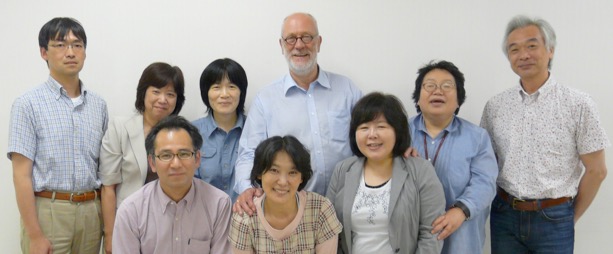
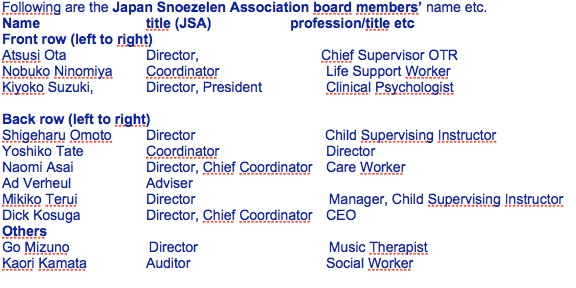
ISNA-mse.org
